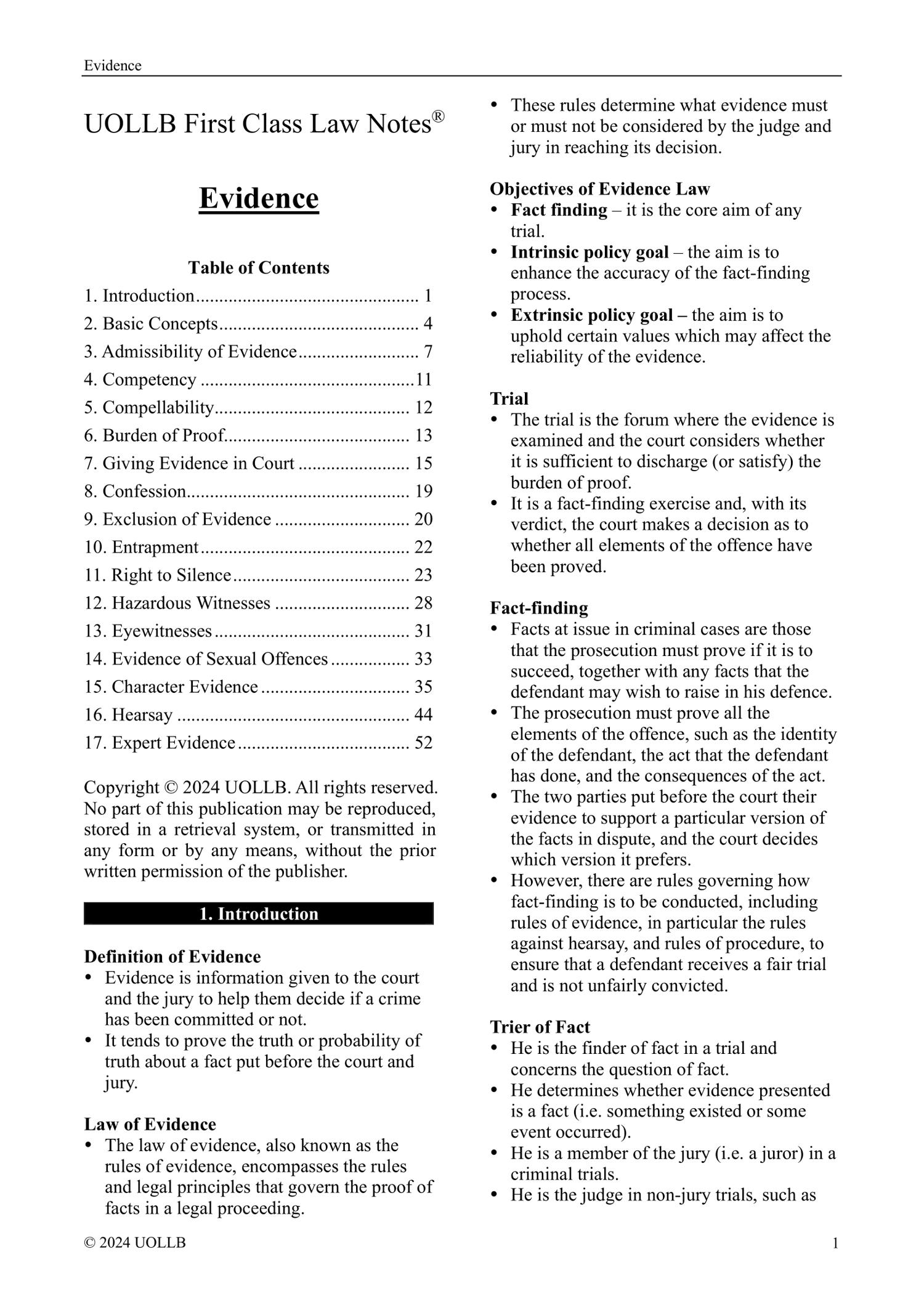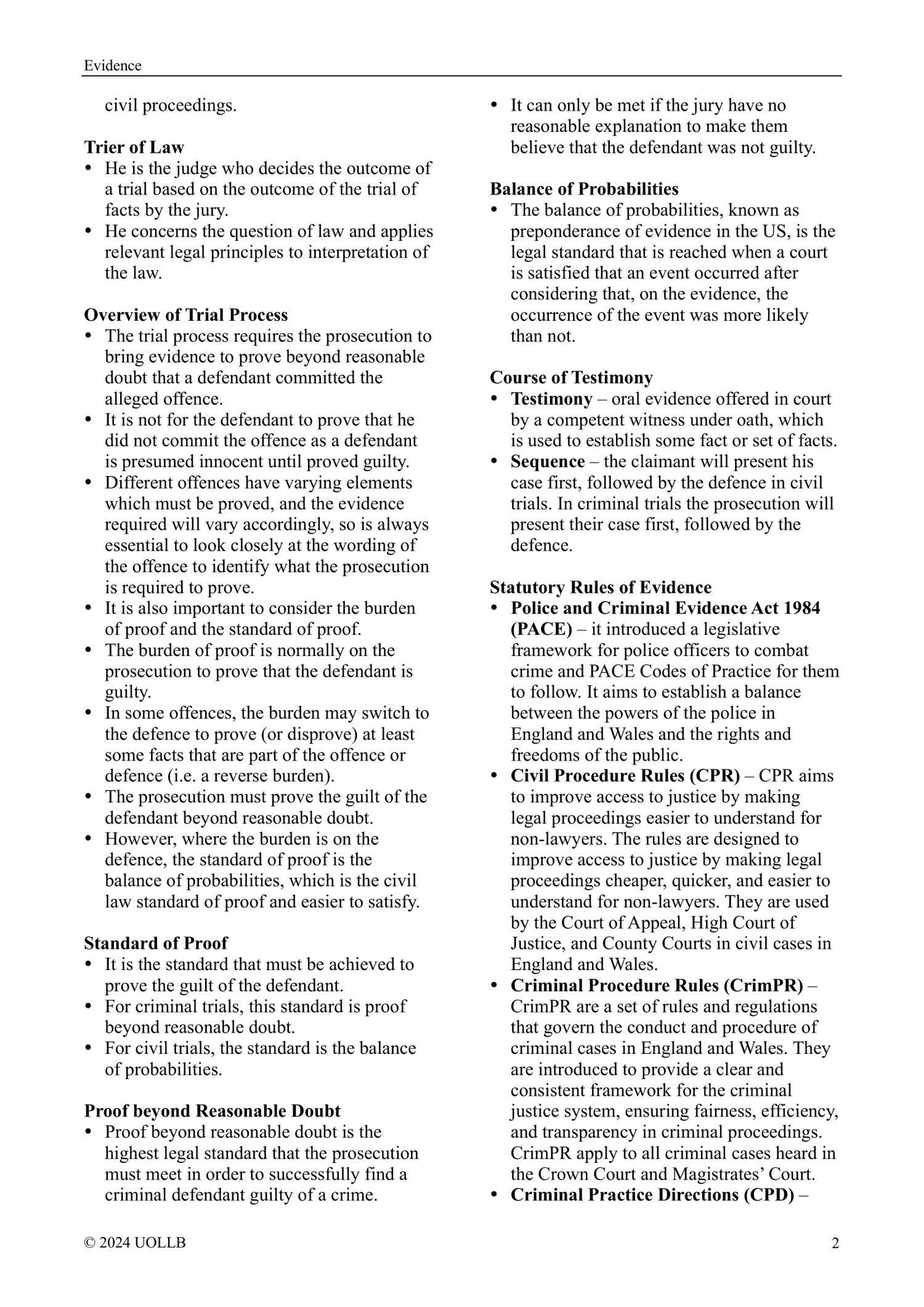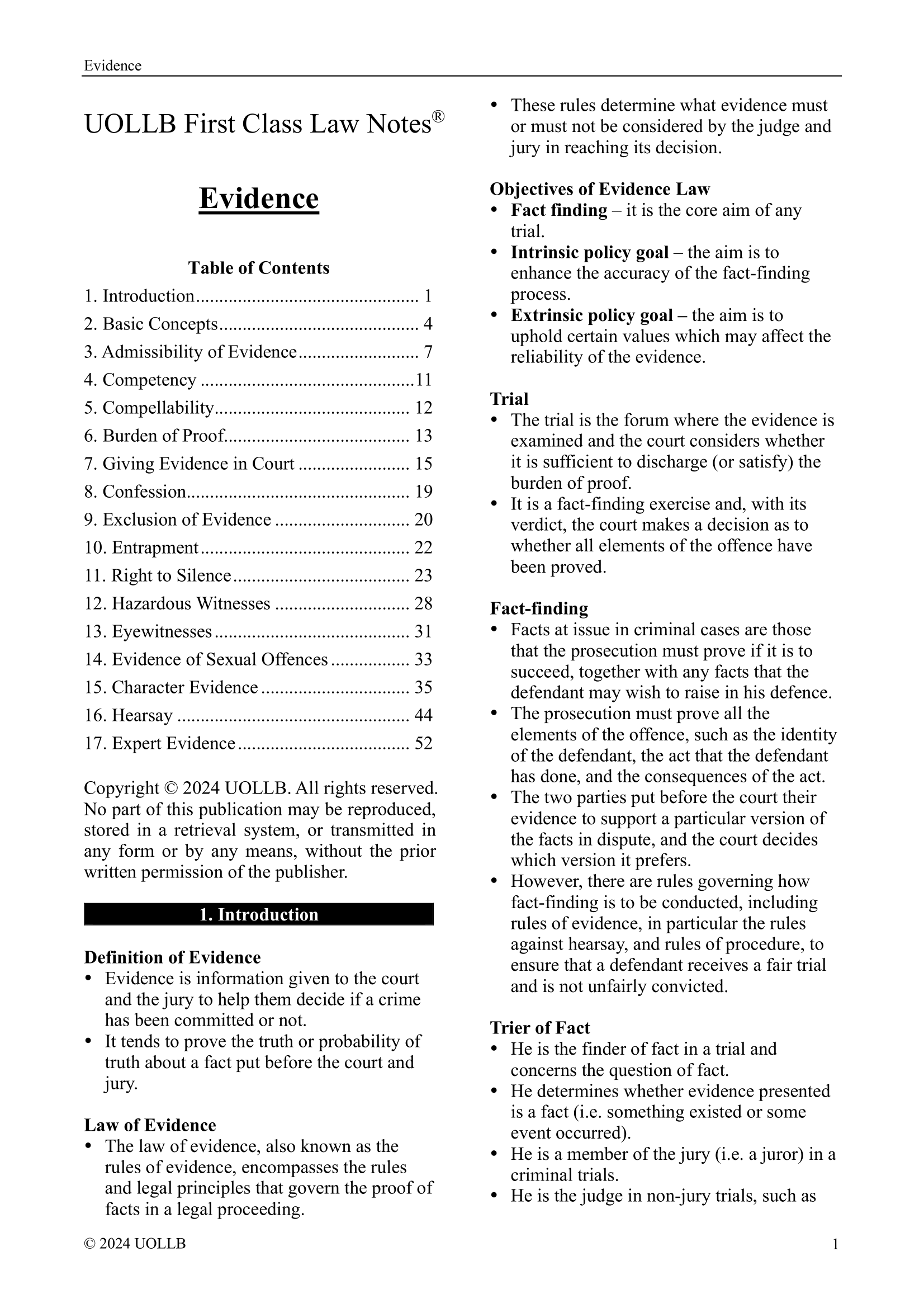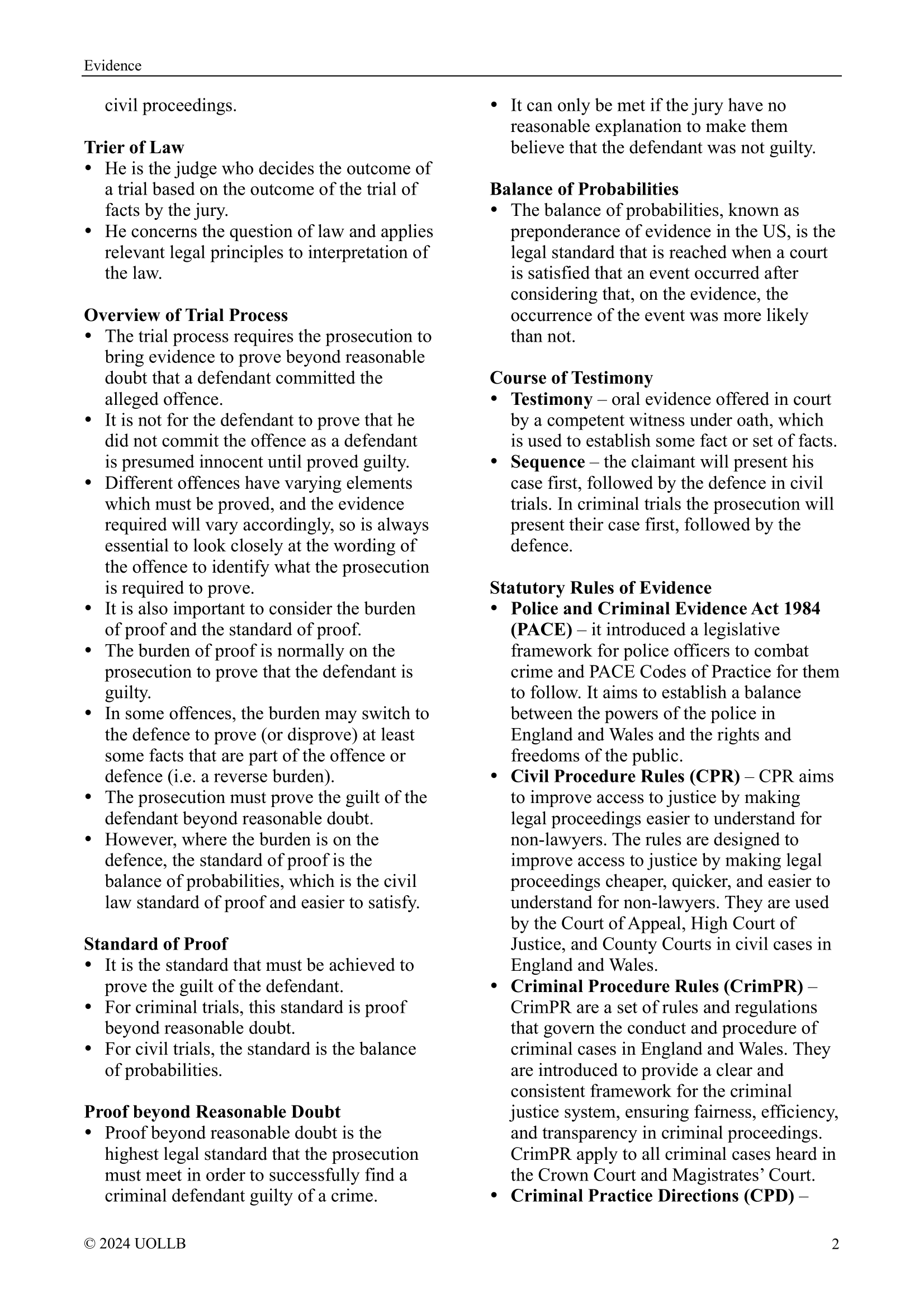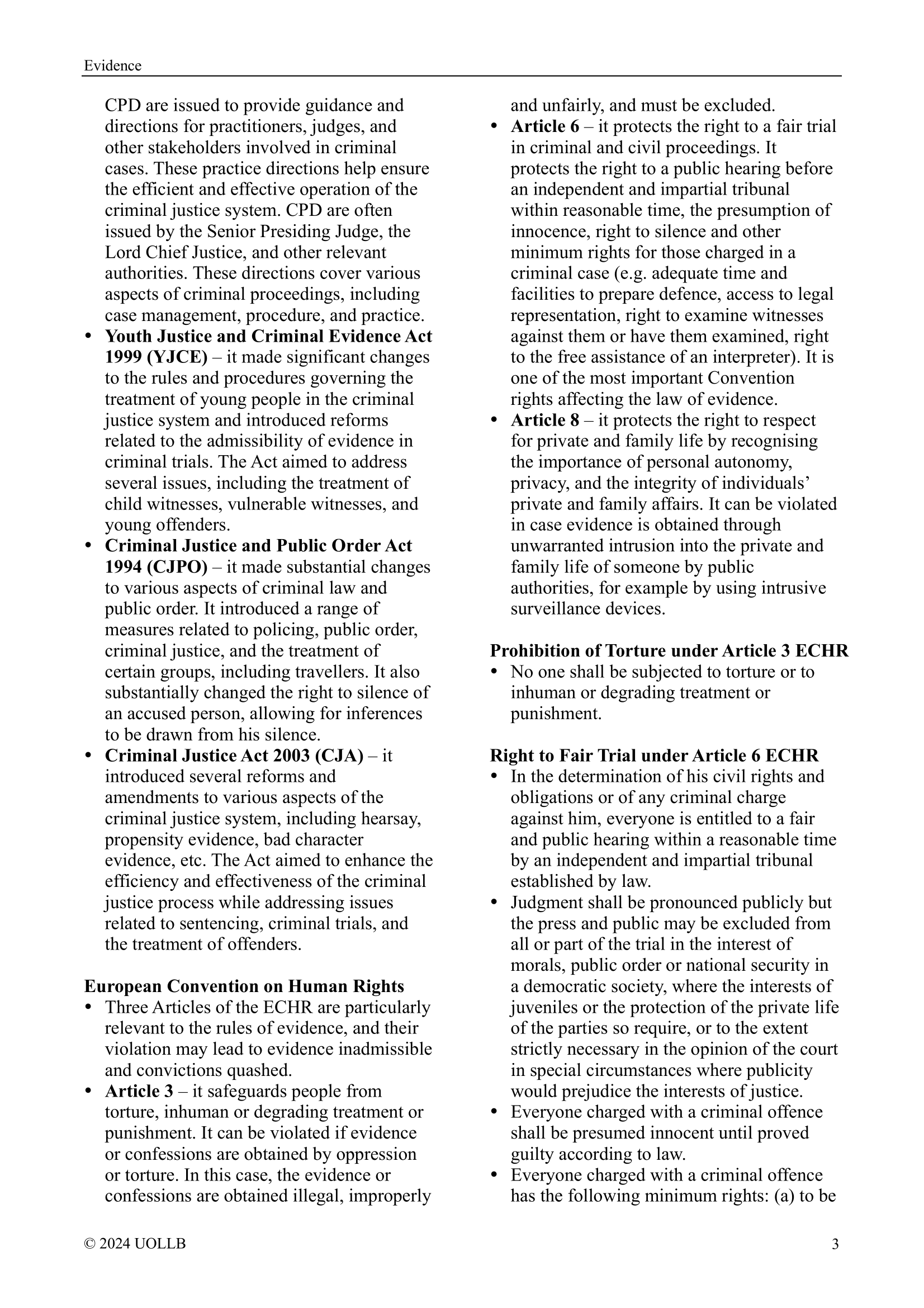Evidence deals with on the principles, rules, and practices related to the admission, presentation and evaluation of evidence in legal proceedings. Although it is not required for entry into bar training, it is heavily assessed in the SQE. You can choose to study this module in Year 3. Here is a summary of the topics covered in this module:
Basic Concepts of the Law of Evidence: The Law of Evidence governs the rules and principles regarding the presentation, admissibility, relevance, weight, and types of evidence in legal proceedings. It ensures fairness, efficiency, and accuracy in the administration of justice by establishing guidelines for the use and evaluation of evidence.
Relevance of Evidence: Evidence is considered relevant if it has a logical connection to the facts in dispute and tends to prove or disprove them. Relevance is determined based on the probative value of the evidence in relation to the issues in the case.
Admissibility of Evidence: Admissibility refers to whether evidence is allowed to be presented in court. It involves applying rules and standards to determine if the evidence is legally permissible. Admissibility rules cover areas such as hearsay, authentication, privilege, and exclusion of unfairly obtained evidence.
Weight of Evidence: The weight of evidence refers to its persuasive value or probative force in establishing the truth of a fact. The weight of evidence is assessed by considering factors such as the credibility of witnesses, the consistency of evidence, and its reliability in light of other available evidence.
Procedural Context: The Law of Evidence operates within a procedural framework that includes rules and practices governing the presentation, examination, and cross-examination of witnesses, the burden of proof, the admissibility of expert testimony, and the introduction of documentary or physical evidence.
Types of Evidence: Evidence can be categorised into various types, including testimonial evidence (oral or written statements of witnesses), documentary evidence (written records or contracts), real evidence (physical objects or exhibits), and demonstrative evidence (visual aids or diagrams).
Objectives of Evidence Law: The objectives of evidence law include ensuring fairness in legal proceedings, facilitating the search for truth, promoting efficiency in the administration of justice, safeguarding the rights of parties, and maintaining public confidence in the legal system. Evidence law aims to strike a balance between admitting reliable evidence and excluding unreliable or prejudicial evidence.
Determination of Probative Value: The determination of probative value involves assessing the relevance, reliability, and credibility of evidence to determine its weight in establishing the truth or falsehood of a fact. Factors such as the quality of the evidence, consistency with other evidence, corroborating evidence, and the credibility of witnesses are considered in evaluating the probative value of evidence.
Burden of Proof: The burden of proof refers to the responsibility of a party to establish the truth or validity of a particular claim or issue in a legal proceeding. The party with the burden of proof must present sufficient evidence to convince the trier of fact (judge or jury) of the truth of his claim.
Legal and Evidential Burdens: The burden of proof can be divided into legal and evidential burdens. The legal burden refers to the overall responsibility of proving a claim or issue, while the evidential burden refers to the duty of producing sufficient evidence to raise an issue or create a presumption in favour of a particular claim.
Burden of Proof in Criminal Trials: In criminal trials, the burden of proof rests with the prosecution. The prosecution must prove the guilt of the accused beyond a reasonable doubt. The accused is presumed innocent until proven guilty, and the burden remains on the prosecution to establish guilt.
Burden of Proof in Civil Trials: In civil trials, the burden of proof generally rests with the party asserting a claim or seeking a remedy. The standard of proof is based on the balance of probabilities, requiring the party to establish that it is more likely than not that his claim is true.
Standard of Proof in Civil Proceedings: In civil proceedings, the standard of proof is based on the balance of probabilities. This means that the party with the burden of proof must establish that it is more probable than not that his claim is true. It is a lower standard than the "beyond a reasonable doubt" standard used in criminal trials.
Standard of Proof in Criminal Proceedings: In criminal proceedings, the standard of proof is beyond a reasonable doubt. The prosecution must prove the guilt of the accused to such a high degree that there is no reasonable doubt in the minds of the trier of fact regarding his guilt.
Presumption of Innocence: The presumption of innocence is a fundamental principle in criminal law that states an accused person is presumed innocent until proven guilty. It places the burden of proof on the prosecution to prove the guilt of the accused beyond a reasonable doubt. The presumption ensures that the accused is not unfairly treated or stigmatised before his guilt is established.
Confessions: Confessions are statements made by a person admitting his guilt or involvement in a crime. They can be powerful evidence in criminal cases. However, the admissibility and reliability of confessions are subject to strict rules and safeguards, including voluntariness, proper cautioning, and the absence of coercion or undue influence.
Improperly Obtained Evidence: Improperly obtained evidence refers to evidence that has been obtained in violation of legal or constitutional rights, such as evidence obtained through unlawful searches, seizures, or interrogations. Such evidence may be excluded from trial to protect the integrity of the legal system and safeguard individual rights.
Using and Excluding Confessions: Courts carefully evaluate the admissibility and reliability of confessions. If a confession is deemed voluntary, properly obtained, and meets legal requirements, it can be admitted as evidence. However, if it is obtained through coercion, duress, or in violation of a suspect's rights, it may be excluded from trial as unreliable or inadmissible.
Using and Excluding Improperly Obtained Evidence: Improperly obtained evidence, including confessions, may be excluded from trial through the application of exclusionary rules. These rules aim to deter law enforcement from engaging in unlawful practices and prevent the use of evidence obtained in violation of a person's rights. The exclusionary rule varies in different jurisdictions but generally excludes evidence obtained through unconstitutional means.
Entrapment: Entrapment occurs when law enforcement induces or encourages a person to commit a crime he would not have otherwise committed. If entrapment is established, the court may exclude evidence obtained as a result of the entrapment or even dismiss the case altogether, considering it an abuse of the legal process.
The Right to Silence: The right to silence allows an accused person to refuse to answer questions or provide self-incriminating statements during police interrogations or court proceedings. It protects individuals from being compelled to testify against themselves. The exercise of the right to silence generally cannot be used against a person as evidence of guilt.
Adverse Inferences: Adverse inferences may be drawn when a person fails to answer questions or provide information when he has the opportunity to do so. In some jurisdictions, if a person exercises the right to silence during police questioning or fails to mention relevant facts that he later relies on in court, the jury or judge may draw inferences unfavourable to the person.
The Criminal Justice and Public Order Act 1994: The Criminal Justice and Public Order Act 1994 is a legislation in the United Kingdom that introduced significant changes in criminal law and procedure. It included provisions related to public order offences, police powers, and criminal justice reforms, such as the introduction of the "two strikes and you're out" rule for serious offences and provisions for handling rave parties.
Hazardous Witness Testimony: Hazardous witness testimony refers to the evidence provided by witnesses whose credibility or reliability is considered questionable due to factors such as their vulnerability, unreliability, or potential for bias. Hazardous witness testimony requires careful evaluation and consideration by the court to determine its weight and reliability.
Judicial Warnings: Judicial warnings are cautionary instructions provided by the judge to the jury regarding the need for caution when evaluating certain types of evidence or circumstances. These warnings aim to guide the jury's assessment of evidence and prevent them from drawing unwarranted conclusions or being unduly influenced by particular factors.
Makanjuola Warnings: Makanjuola warnings derive from the case of R v Makanjuola and are specific warnings given by the judge to the jury when dealing with the evidence of an accomplice or co-defendant. The warnings highlight the potential risks and concerns associated with relying on the evidence of an accomplice, emphasising the need for caution and corroboration.
Directions about Lying Defendant: Directions about a defendant's lies are instructions provided by the judge to the jury when the defendant has been found to have made false statements or lies during the course of the trial. The judge guides the jury on how to consider and evaluate the defendant's lies in their overall assessment of the evidence and the credibility of the defendant.
Eyewitness Identification: Eyewitness identification refers to the process where a person identifies someone he has seen before as the perpetrator of a crime. Eyewitness identification evidence can be powerful but also subject to limitations and potential inaccuracies due to factors such as memory distortions, suggestive procedures, or witness biases.
Dangers of Eyewitness Identification: The dangers of eyewitness identification refer to the potential pitfalls and risks associated with relying solely on eyewitness testimony. Factors such as the fallibility of human memory, suggestibility, cross-racial identification challenges, and biases can lead to mistaken identifications and wrongful convictions.
Pre-trial Identification Procedures: Pre-trial identification procedures are the methods used to identify a suspect before the trial, such as line-ups, photo arrays, or show-ups. Properly conducted identification procedures should follow established guidelines to minimise suggestiveness and ensure fairness and accuracy in the identification process.
Directions to the Jury: Directions to the jury are instructions provided by the judge to the jury regarding the law, legal principles, and the proper approach to evaluating evidence. The judge provides guidance on the applicable legal standards, burden of proof, credibility assessment, and any specific considerations or factors relevant to the case.
Withdrawal of the Case and Evidence: The withdrawal of the case and evidence refers to the decision by the prosecution to discontinue the case and not present evidence to the court. This may occur due to various reasons, such as insufficient evidence, a change in circumstances, or a determination that it is not in the public interest to proceed with the case.
Critical Evaluation of Hazardous Witness Testimony: The critical evaluation of hazardous witness testimony involves a thorough and careful assessment of the credibility, reliability, and potential biases of witnesses whose testimony may be considered hazardous. It requires considering factors such as witness credibility, consistency, corroboration, and any potential motives or influences that may affect their testimony.
Critical Evaluation of Judicial Warnings: The critical evaluation of judicial warnings involves assessing the effectiveness and appropriateness of the warnings given by the judge to the jury. It includes considering whether the warnings adequately address the specific concerns and risks associated with the evidence or circumstances at hand. The critical evaluation of judicial warnings involves examining whether the warnings were clear, balanced, and properly tailored to the specific issues in the case. It also involves assessing whether the warnings effectively guided the jury in their evaluation of the evidence and decision-making process.
Evidence of a Complainant's Extraneous Sexual Behaviour in Trials of Sexual Offences: This refers to the admissibility and use of evidence relating to a complainant's previous sexual behaviour or activities in trials involving sexual offences. It involves the consideration of whether such evidence is relevant, permissible, and fair in the context of the case.
Legislative Background: The legislative background refers to the laws and provisions that govern the admissibility and use of evidence of a complainant's extraneous sexual behaviour. In many jurisdictions, specific legislation has been enacted to regulate the introduction of such evidence in order to balance the rights of the accused with the protection of the complainant.
Youth Justice and Criminal Evidence Act 1999 (YJCEA): The YJCEA is an important legislation in the United Kingdom that introduced significant reforms in relation to the treatment of evidence in sexual offence cases. It provides guidelines and restrictions on the admissibility of evidence of a complainant's sexual behaviour and sets out procedures to protect vulnerable witnesses.
Sections 41–43 and Its Interpretation in Case Law: Sections 41–43 of the YJCEA 1999 specifically address the admissibility of evidence of a complainant's sexual behaviour. These sections outline the circumstances under which such evidence may be admissible, such as when it is relevant to an issue of consent or to support the credibility of the complainant. Case law has played a crucial role in interpreting and applying these provisions in specific cases.
Critical Evaluation of Evidence of a Complainant's Extraneous Sexual Behaviour: The critical evaluation of evidence of a complainant's extraneous sexual behaviour involves a careful assessment of its relevance, probative value, and potential prejudicial effect. It requires considering factors such as the specific purpose for which the evidence is offered, its potential impact on the fairness of the trial, and whether there are alternative means of achieving the same evidential purpose.
Character Evidence: Character evidence refers to evidence that relates to a person's general reputation, traits, or disposition. It aims to establish a person's character as either good or bad, which may have implications for his credibility or propensity to commit certain acts.
Good Character Evidence: Good character evidence is evidence that supports a person's positive character traits or reputation. It is typically introduced to demonstrate that the accused is of good character and less likely to have committed the offence charged.
Bad Character Evidence: Bad character evidence, on the other hand, is evidence that suggests negative character traits or previous misconduct of the accused. It aims to establish the accused's propensity to commit the offence charged.
Admissibility Gateways for Bad Character Evidence: The admissibility of bad character evidence is subject to specific gateways or criteria set out in legislation or case law. These gateways provide circumstances in which such evidence may be admissible, such as when it is relevant to an issue in the case, or when the accused has introduced evidence of his good character.
Critical Evaluation of Character Evidence: The critical evaluation of character evidence involves assessing the relevance, probative value, and potential prejudicial effect of such evidence. It requires considering the specific purpose for which the evidence is offered, the weight it carries in relation to other evidence, and the potential for it to lead to unfair prejudice or an improper inference about the accused's guilt.
The Rule against Hearsay: The rule against hearsay is a fundamental principle in the law of evidence that generally prohibits the admission of out-of-court statements offered for the truth of the matter asserted. It restricts the use of secondhand or indirect evidence and emphasises the importance of firsthand testimony and cross-examination.
Scope of the Rule against Hearsay: The rule against hearsay applies to statements made by individuals outside the courtroom that are offered as evidence of the truth of what is asserted in those statements. It covers oral and written statements, as well as conduct that is intended as an assertion.
Rationale for the Rule against Hearsay: The rationale behind the rule against hearsay is to ensure the reliability and fairness of evidence presented in court. Hearsay statements are generally considered less reliable than firsthand testimony, as they lack the opportunity for cross-examination and may be based on rumour, misunderstanding, or faulty memory. Excluding hearsay evidence aims to protect against the admission of unreliable or untested statements.
The Definition of Hearsay: Hearsay is generally defined as an out-of-court statement made by a person, offered as evidence to prove the truth of the matter stated in the statement. The statement can be an oral or written assertion, or it can be conduct that is intended to communicate a statement.
Exceptions to the Rule against Hearsay: The rule against hearsay has several recognised exceptions that allow for the admission of hearsay evidence in certain circumstances. These exceptions are based on various rationales, such as the presence of guarantees of trustworthiness, necessity, reliability, or the unavailability of the original declarant. Common exceptions include statements made for medical diagnosis or treatment, business records, spontaneous statements, and dying declarations.
The Impact of Article 6(3)(D) of the European Convention on Human Rights: Article 6(3)(D) of the European Convention on Human Rights guarantees the right of an accused person to examine or have examined witnesses against them. This right has implications for the admissibility of hearsay evidence, as the European Court of Human Rights has emphasised the importance of allowing the accused to challenge and cross-examine witnesses, including those whose statements are presented as hearsay.
Expert Evidence: Expert evidence refers to the testimony or opinion provided by individuals who possess specialised knowledge, skills, or expertise in a particular field relevant to the issues in a legal case. It is intended to assist the court in understanding complex matters and reaching a just and informed decision.
Admissibility of Expert Evidence: The admissibility of expert evidence is determined by the relevant legal rules and principles of the jurisdiction. Generally, expert evidence must meet certain criteria to be admissible, such as relevance, reliability, and the expert's qualifications. The court assesses whether the expert's opinion is based on a reliable methodology and whether it will assist the trier of fact in understanding the evidence.
Evaluation of the Law and Practice of Expert Evidence: The law and practice of expert evidence are subject to ongoing evaluation and scrutiny. This involves assessing the effectiveness, fairness, and reliability of expert evidence in legal proceedings. Evaluations may consider factors such as the qualifications and independence of experts, the use of expert evidence in different types of cases, and the impact on the decision-making process.
Judicial Directions of Expert Evidence: Judicial directions are instructions given by the judge to the jury or fact-finder regarding the treatment and evaluation of expert evidence. These directions guide the fact-finder on how to assess the weight and credibility of expert opinions, considering factors such as the expert's qualifications, methodology, and any limitations or uncertainties in the opinion given by the expert.
Dangers of Expert Evidence: There are potential dangers associated with expert evidence. These include the risk of bias or lack of independence on the part of the expert, the potential for complex or technical evidence to confuse or mislead the fact-finder, and the possibility of conflicting expert opinions that may create uncertainty. There is also a risk that the weight given to expert evidence may overshadow other forms of evidence or improperly influence the decision-making process.
Reforms to Ameliorate Risks of Expert Evidence: Reforms have been introduced in many jurisdictions to address the risks associated with expert evidence. These reforms aim to enhance the reliability, transparency, and fairness of expert evidence. They may include stricter requirements for expert qualifications, disclosure of expert reports and conflicts of interest, the use of joint expert reports, and increased scrutiny of expert evidence by the court.
Critical Evaluation of Evidence: Critical evaluation of evidence involves assessing its relevance, credibility, probative value, and potential flaws or weaknesses. It requires careful consideration of the sources of evidence, the methodology used, the expertise of the individuals providing the evidence, and any potential biases or limitations. Critical evaluation is crucial in ensuring that only reliable and trustworthy evidence is given weight in the decision-making process.
Evidence provides you with a comprehensive understanding of how evidence is gathered, admitted, and assessed in court to determine the facts of a case. This module equips you with the knowledge and skills necessary to analyse, present, and challenge evidence in legal proceedings.
You can learn more about each topic and relevant case law with our exam-focused Evidence notes.






















